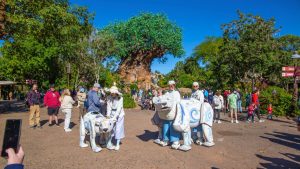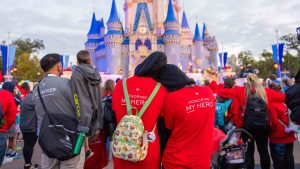On a recent morning, Disney Cruise Line President Tom McAlpin stood in front of 20 new recruits from across Europe and tried to explain why they are spending three days in a building in Central Florida, 60 miles inland and nowhere near a ship.
"Who's worked for a cruise company before?" he asked.
About a quarter of the hands shot up around the room.
"You flew into the airport, took a taxi or a bus to the ship and what were you doing that afternoon? You got a uniform on, and most likely you were working that afternoon. We don't believe in that," he said.
As the cruise line prepares this week to sail for the first time to Europe and more than double its guest capacity with two new ships in the next five years, McAlpin, 47, knows that capitalizing on the Disney brand is more important than ever in an increasingly competitive environment.
There are lots of reasons parents in the United States may be hesitant to pack up their families for an overseas trip. War. Bad exchange rates. Anti-American sentiment.
But Disney is banking that its version of a European vacation — sold in mostly American dollars with all of the typical travel hassles managed by Disney-trained staff — will sell.
Comfort level
Travel agents have noted the draw. The inaugural May 12 voyage from Port Canaveral to Barcelona, Spain, and the following 10- and 11-night Mediterranean cruises through August are proving popular and, so far, the company has marketed only to Americans.
"I have clients who will not touch a Disney cruise because of the emphasis on Disney," said Bob Cook, director of cruise sales for Altamonte Springs-based Go Travel. "[But] there are people who are calling who are looking for that comfort level so they can go abroad safely. It's good, old America, Walt Disney, apple pie."
McAlpin, who joined the company in 1994, four years before the first ship set sail, is focused on bringing a larger share of first-time European travelers to Disney cruises.
"We're going to be a small player," he said. "How are we going to compete against the big players out there? Everything we do on board the ship has to be differentiated."
With just two ships, compared with Carnival Corp.'s 82 or Royal Caribbean International's 34, Disney remains dwarfed by the competition. Carnival has 17 ships on order among its 10 brands before 2011. Royal Caribbean, including its Royal Celebrity brand, has seven on the way.
The two Disney ships on order, expected to be done in 2011 and 2012, are about 45 percent larger than the existing Disney Magic and Disney Wonder. But they are unlikely to send much of a ripple through the industry.
"I wouldn't expect Disney to have a big impact," said Jake Balzer, who analyzes the cruise industry for Guzman & Company.
More cruise lines are moving now to the Mediterranean and Asia as the Caribbean market has softened and prices have dropped — an effect he attributed, in part, to Hurricane Katrina "hangover" and a slowing housing market.
Because Disney's key market is families looking to sail short cruises in the Caribbean, it could face some hurdles in the Mediterranean.
"Mediterranean cruises are typically a higher-end kind of a cruise; it's pricier. I don't know how well that's going to do," Balzer said.
But McAlpin, who spent eight years with Royal Caribbean, and his top executives, some of whom also came from the big cruise lines, like to take risks.
On Disney cruise ships, there are no casinos, typically one of the top activities on other cruise lines. Passengers eat dinner at a different restaurant — though with the same wait staff — every night versus the traditional single dining hall on other ships. And children, lots of them, are everywhere.
"In hindsight, we could have really messed up a lot of things," said Chief Financial Officer James Heaney. "Coming from the cruise industry, a lot of us were concerned about that [no casinos] initially. It actually turned out to be an advantage."
Art of negotiation
McAlpin, who grew up in Miami and at 14 took a cleaning and painting job in a boatyard, is comfortable on the water.
He lives on Lake Hancock west of Windermere with his family and water skis competitively. After graduating from Florida State University, McAlpin became a certified public accountant and eventually landed in the finance department at Royal Caribbean. He remembers sitting across the negotiating table from former Walt Disney World President Al Weiss.
At the time, Disney had decided to end its partnership with Premier Cruise Line and was considering a partnership with Royal Caribbean before it ultimately decided to launch its own line.
"We never made a deal happen," McAlpin said of his experience with Weiss.
But soon after, he went to work for Weiss, starting as a finance vice president and becoming president of the company in 2004.
"He taught me a lot about the art of negotiation," McAlpin said of his former boss.
And while McAlpin knew the industry, at Disney he found himself part of a team charged with building the company from scratch.
One immediate order of business: buy an island.
Disney wanted its own private island that could be billed as an unrivaled relaxation experience — something that would be the ultimate contradiction to a busy, harried day of thrill rides at one of its theme parks. (There is, however, a gift shop on the island.)
A team narrowed the islands for sale down to three, with the main qualifications being that the waters be deep enough for the ship to dock and the location be within about 220 miles of Port Canaveral so the ship could easily return to its home port.
In a helicopter hovering above the Caribbean, McAlpin looked out over the water to a virtually untouched 1,000-acre island.
"When we landed at Castaway Cay, I knew it was the place," he said.
Of course, it wasn't called Castaway Cay then. The island with about 500 developable acres was known as Gorda Cay and was virtually untouched except for a primitive landing strip used as a former drug-running drop.
Today that landing strip, in typical Disney style, is decorated with old airplanes painted with "Castaway Cay Airways" emblems and is used by a tram that takes adults to a private beach away from the kids.
Assets are mobile
The company is aiming for the success of its Caribbean cruises to spill over to the new Mediterranean offerings. Next year, one of Disney's ships will sail back through the Panama Canal, as it did in 2005, to offer West Coast cruises out of the Port of Los Angeles.
Questions remain about where the two new ships on order from Meyer Werft shipyard in Germany will be stationed when they arrive in 2011 and 2012.
A permanent home in California or Europe is possible.
"The nature of our business is that our assets are mobile, and that gives us huge international capabilities," McAlpin said. "The other thing that's real exciting is that we've filled the [existing] ships with Americans. If you think about the potential of this market, it's even broader when you open it up to other English-speaking countries."
Beth Kassab can be reached at bkassab@orlandosentinel.com or 407-420-5448.
Art of negotiation
McAlpin, who grew up in Miami and at 14 took a cleaning and painting job in a boatyard, is comfortable on the water.
He lives on Lake Hancock west of Windermere with his family and water skis competitively. After graduating from Florida State University, McAlpin became a certified public accountant and eventually landed in the finance department at Royal Caribbean. He remembers sitting across the negotiating table from former Walt Disney World President Al Weiss.
At the time, Disney had decided to end its partnership with Premier Cruise Line and was considering a partnership with Royal Caribbean before it ultimately decided to launch its own line.
"We never made a deal happen," McAlpin said of his experience with Weiss.
But soon after, he went to work for Weiss, starting as a finance vice president and becoming president of the company in 2004.
"He taught me a lot about the art of negotiation," McAlpin said of his former boss.
And while McAlpin knew the industry, at Disney he found himself part of a team charged with building the company from scratch.
One immediate order of business: buy an island.
Disney wanted its own private island that could be billed as an unrivaled relaxation experience — something that would be the ultimate contradiction to a busy, harried day of thrill rides at one of its theme parks. (There is, however, a gift shop on the island.)
A team narrowed the islands for sale down to three, with the main qualifications being that the waters be deep enough for the ship to dock and the location be within about 220 miles of Port Canaveral so the ship could easily return to its home port.
In a helicopter hovering above the Caribbean, McAlpin looked out over the water to a virtually untouched 1,000-acre island.
"When we landed at Castaway Cay, I knew it was the place," he said.
Of course, it wasn't called Castaway Cay then. The island with about 500 developable acres was known as Gorda Cay and was virtually untouched except for a primitive landing strip used as a former drug-running drop.
Today that landing strip, in typical Disney style, is decorated with old airplanes painted with "Castaway Cay Airways" emblems and is used by a tram that takes adults to a private beach away from the kids.
Assets are mobile
The company is aiming for the success of its Caribbean cruises to spill over to the new Mediterranean offerings. Next year, one of Disney's ships will sail back through the Panama Canal, as it did in 2005, to offer West Coast cruises out of the Port of Los Angeles.
Questions remain about where the two new ships on order from Meyer Werft shipyard in Germany will be stationed when they arrive in 2011 and 2012.
A permanent home in California or Europe is possible.
"The nature of our business is that our assets are mobile, and that gives us huge international capabilities," McAlpin said. "The other thing that's real exciting is that we've filled the [existing] ships with Americans. If you think about the potential of this market, it's even broader when you open it up to other English-speaking countries."
Beth Kassab can be reached at bkassab@orlandosentinel.com or 407-420-5448.





